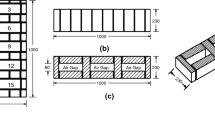Abstract
Porous face bricks on the outside of a building wall exhibit evaporative cooling after absorbing water. Thus, these bricks are promising for use as a passive energy-saving building technology. Artificial watering is an effective method to ensure a sufficient water supply for effective evaporative cooling. However, improper watering measures may result in the waste of water resources while failing to achieve the evaporative cooling effect. In this paper, studies were conducted on a composite wall composed of a facing layer and a base layer as follows. (1) The mass moisture content variations in the porous face brick with respect to soaking time were measured, and the feasibility of using this type of face brick as an evaporative cooling carrier was investigated. (2) The relationship between mass moisture content and the evaporation capacity of the porous face brick was determined under stable conditions. A critical mass moisture content for the porous face brick was determined through analysis of the measurement data. (3) A field measurement was performed to verify the feasibility of using the critical mass moisture content as a criterion for watering. The results indicate that the temperature and heat flows at the inner and outer surfaces of the composite wall were reduced significantly. However, when the mass moisture content exceeded the critical mass moisture content, the evaporative cooling capability tended to stabilize with further watering. Therefore, the critical mass moisture content of the porous face brick can be used as a criterion for watering to conserve water while facilitating the evaporative cooling effect.










Similar content being viewed by others
References
Chen, W. (2011). Thermal analysis on the cooling performance of a wet porous evaporative plate for building. Energy Conversion and Management, 52, 2217–2226.
Giabaklou, Z., & Ballinger, J. A. (1996). A passive evaporative cooling system by natural ventilation. Building and Environment, 31, 503–507.
He, J. (2011). A design supporting simulation system for predicting and evaluating the cool microclimate creating effect of passive evaporative cooling walls. Building and Environment, 46, 584–596.
He, J., & Hoyano, A. (2009). A 3D CAD-based simulation tool for prediction and evaluation of the thermal improvement effect of passive cooling walls in the developed urban locations. Solar Energy, 83, 1064–1075.
He, J., & Hoyano, A. (2010). Experimental study of cooling effects of a passive evaporative cooling wall constructed of porous ceramics with high water soaking-up ability. Building and Environment, 45, 461–472.
Hong, T. Z. (2009). A close look at the China Design Standard for Energy Efficiency of Public Buildings. Energy and Buildings, 41, 426–435.
Intergovernmental Panel on Climate Change (IPCC). (2007). Climate change 2007: the physical science basis. Online: http://www.ipcc.ch/.
Kharrufa, S. N., & Adil, Y. (2012). Upgrading the building envelope to reduce cooling loads. Energy and Buildings, 55, 389–396.
Kong, X. F., Lu, S. L., & Wu, Y. (2012). A review of building energy efficiency in China during “Eleventh Five-Year Plan” period. Energy Policy, 41, 624–635.
Liang, J., Li, B. Z., Wu, Y., & Yao, R. M. (2007). An investigation of the existing situation and trends in building energy efficiency management in China. Energy and Buildings, 39, 1098–1106.
Meng, Q. L., Wang, Z. G., Zhang, Y. F., & Zhao, L. H. (2007). Rainfall identification and estimation in Guangzhou area used for building energy simulation. Building and Environment, 42, 3112–3122.
Naticchia, B., D’Orazio, M., & Carbonari, A. (2010). Energy performance evaluation of a novel evaporative cooling technique. Energy and Buildings, 42, 1926–1938.
Oliveira, J. T., Hagishima, A., & Tanimoto, J. (2009). Estimation of passive cooling efficiency for environmental design in Brazil. Energy and Buildings, 41, 809–813.
Pagliarini, G., & Rainieri, S. (2011). Dynamic thermal simulation of a glass-covered semi-outdoor space with roof evaporative cooling. Energy and Buildings, 43, 592–598.
Pearlmutter, D., & Rosenfeld, S. (2008). Performance analysis of a simple roof cooling system with irrigated soil and two shading alternatives. Energy and Buildings, 40, 855–864.
People’s Republic of China National Standard. (2003). Test method for wall brick.
Pérez-Lombard, L., Ortiz, J., & Pout, C. (2008). A review on buildings energy consumption information. Energy and Buildings, 40, 394–398.
Pires, L., Silva, P. D., & Castro Gomes, J. P. (2011). Performance of textile and building materials for a particular evaporative cooling purpose. Experimental Thermal and Fluid Science, 35, 670–675.
Qiu, G. Y., & Ben-Asher, J. (2010). Experimental determination of soil evaporation stages with soil surface temperature. Soil Science Society of America Journal, 74, 13–22.
Wanphen, S., & Nagano, K. (2009). Experimental study of the performance of porous materials to moderate the roof surface temperature by its evaporative cooling effect. Building and Environment, 44, 338–351.
Xinhuanet. (2011). National Development and Reform Commission: the energy conservation and emission reduction goals during the China’s 11th Five-Year Plan period were basically completed. Online: http://news.xinhuanet.com/fortune/2011-09/28/c_122098567.htm.
Yu, Z.C. (2011). The building energy efficiency rate will be improved during the China’s 12th Five-Year Plan period. Online: http://www.cstcmoc.org.cn/plus/view.php?aid=164.
Zhang, Y., Meng, Q. L., & Chen, Y. R. (2008). Development of dynamic laboratory of hot-humid climatic wind tunnel for evaporation cooling under solar radiation. Acta Energiae Solaris Sinica, 29, 509–514.
Acknowledgments
This research work was funded by the National Key Technology R&D Program (No. 2011BAJ01B01), The National Natural Science Foundation of China (No. 51308223), Guangzhou Pearl River Science & Technology New Star Project (No. 2011j2200098), and State Key Lab of Subtropical Building Science, South China University of Technology (No. 2015ZC14).
Author information
Authors and Affiliations
Corresponding author
Rights and permissions
About this article
Cite this article
Zhang, L., Liu, X., Meng, Q. et al. Experimental study on the impact of mass moisture content on the evaporative cooling effect of porous face brick. Energy Efficiency 9, 511–523 (2016). https://doi.org/10.1007/s12053-015-9377-8
Received:
Accepted:
Published:
Issue Date:
DOI: https://doi.org/10.1007/s12053-015-9377-8




